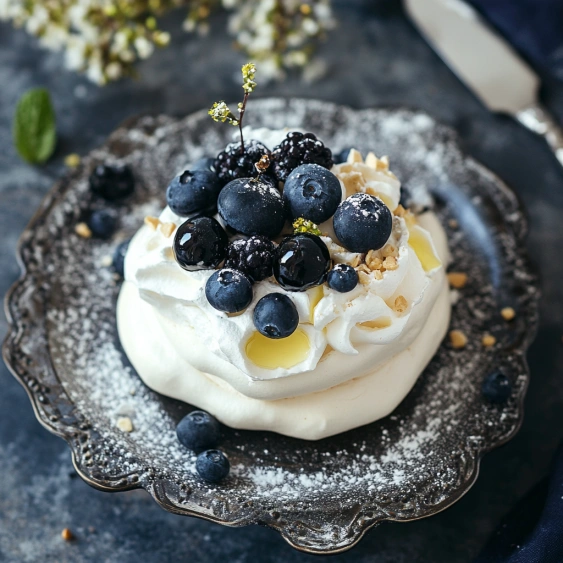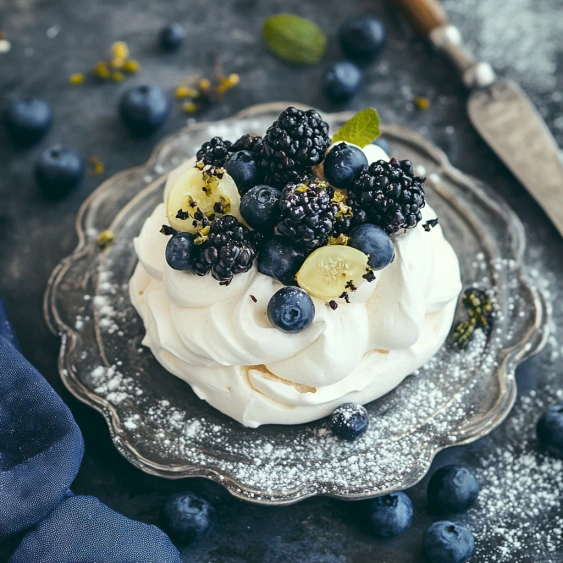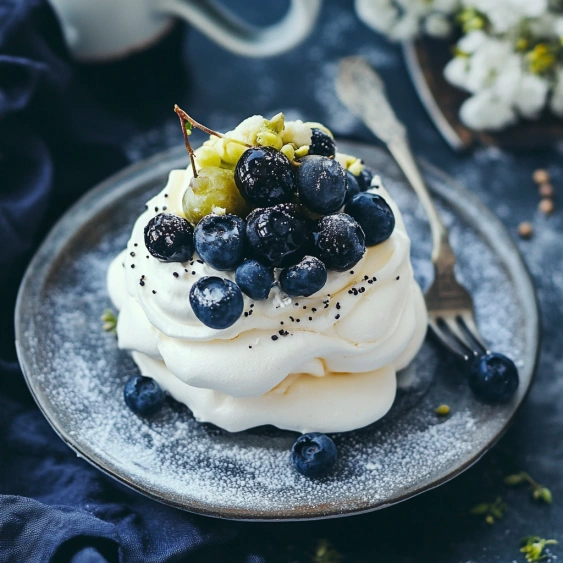 Pin it
Pin it
This delicate mini pavlova recipe creates the perfect balance of crispy meringue exterior with a soft, marshmallowy interior, all topped with pillowy whipped cream and fresh fruit. The combination of textures and flavors makes it an impressive yet surprisingly simple dessert for any occasion.
I discovered this recipe while planning a summer dinner party and needed something light yet impressive. The way my guests' eyes widened when I brought these to the table made them an instant staple in my entertaining repertoire.
Ingredients
- Egg whites: At room temperature ensures maximum volume and stability in your meringue
- Granulated sugar: Creates the structure and sweetness needed for perfect pavlovas
- Corn starch: Helps create that signature marshmallowy center
- Lemon juice: Adds a subtle tang and helps stabilize the meringue
- Cream of tartar: Acts as an insurance policy for stiff peaks that hold their shape
- Vanilla extract: Provides depth of flavor to the otherwise simple meringue
- Heavy whipping cream: Must be cold for the best whipping results
- Fresh blueberries: Add a burst of color and tartness that cuts through the sweetness
- Pistachios: Contribute a savory crunch that balances the overall dessert
Step-by-Step Instructions
- Prepare the oven and mixer:
- Begin by preheating your oven to 225°F and lining two baking sheets with parchment paper. This low temperature is crucial for slowly drying out the meringue while maintaining its white color. Make sure your mixing bowl and whisk attachment are completely clean and free from any grease.
- Beat the egg whites:
- Start whisking the room temperature egg whites with a pinch of salt at high speed until they become foamy, about 1 minute. Room temperature whites whip up to greater volume than cold ones. The initial foaming stage creates millions of tiny air bubbles that will form the structure.
- Gradually add sugar:
- While continuing to beat at high speed, slowly add the sugar about a tablespoon at a time, allowing each addition to incorporate before adding more. This gradual addition ensures the sugar fully dissolves, preventing a gritty texture. Continue beating for a full 9-10 minutes until the meringue forms stiff, glossy peaks. When lifted, the meringue should stand straight up without flopping over.
- Fold in flavoring and stabilizers:
- Using a rubber spatula, gently fold in the lemon juice and vanilla with about 10-11 full strokes. Then fold in the cornstarch and cream of tartar with another 10-11 strokes. These ingredients stabilize the meringue while adding subtle flavor. The folding motion preserves the air bubbles you worked so hard to create.
- Pipe and shape the pavlovas:
- Transfer the meringue to a piping bag fitted with a Wilton 2D tip. Pipe approximately 2-inch bases on the parchment paper, spacing them 2 inches apart. Use a teaspoon to create a slight depression in the center of each one. This will hold your cream and toppings later.
- Slow bake and cooling:
- Bake for 1 hour and 15 minutes, then turn off the oven without opening the door and let them sit for another 30 minutes. This gradual cooling prevents cracking from temperature shock. The exteriors should be crisp and slightly off-white while the centers remain soft. Allow to cool completely on a rack before adding toppings.
- Prepare the whipped cream:
- In a medium bowl, beat the cold heavy cream with sugar until stiff peaks form, about 3 minutes. The cold temperature helps the cream whip faster and hold its shape better. Be careful not to overwhip or you’ll end up with butter.
- Assemble and serve:
- Pipe the whipped cream onto each cooled pavlova using the same decorative tip. Top with fresh blueberries and chopped pistachios. The lightly salted pistachios provide a perfect contrast to the sweet meringue and cream. Serve immediately for the best texture experience.
 Pin it
Pin it
This dessert always reminds me of my first trip to Australia, where pavlova is considered a national dessert. I fell in love with the contrast between the crisp shell and cloud-like interior. The pistachios were my own addition years later, inspired by a memorable dinner in Sicily where they paired them with fresh berries.
Make-Ahead Options
The unfrosted pavlova shells can be stored in an airtight container at room temperature for up to 2 days. Just be sure they are completely cool before storing and place them in a single layer to prevent crushing. Whipped cream can be prepared up to 4 hours ahead and kept refrigerated, though it may need a quick rewhisk before piping. For a dinner party, I often prepare all components separately and assemble them just before serving for the most impressive presentation.
Troubleshooting Tips
If your meringue is weeping or developing beads of moisture, your sugar likely hasn't fully dissolved during beating. Next time, beat the mixture longer or consider using superfine sugar which dissolves more quickly. Humidity is the enemy of meringue, so avoid making these on particularly damp days. If your pavlovas crack excessively, your oven may be too hot—consider reducing the temperature by 25 degrees and extending the baking time slightly.
Seasonal Variations
While blueberries and pistachios create a beautiful combination, these mini pavlovas are incredibly versatile. In summer, try topping with sliced strawberries, peaches, or raspberries. Fall brings opportunities for pomegranate seeds and figs, while winter citrus segments add bright flavor. You can also swap the vanilla extract in the meringue for other flavors like almond extract, orange blossom water, or even a touch of espresso powder for a more complex base.
 Pin it
Pin it
Serving Suggestions
These mini pavlovas make a stunning centerpiece for a dessert table at parties. For an elegant dinner finale, place each pavlova on individual dessert plates with a small drizzle of fruit coulis around the edges. They also pair beautifully with dessert wines like Moscato or late harvest Riesling. For a more casual presentation, arrange several on a large platter and let guests help themselves, perhaps with a small bowl of extra berries on the side.
Frequently Asked Questions
- → Why do the egg whites need to be at room temperature?
Room temperature egg whites whip up to a greater volume than cold ones. They trap air more efficiently, creating a more stable meringue with better structure and height.
- → What causes pavlovas to crack?
Pavlovas typically crack due to sudden temperature changes. The slow cooling process in the turned-off oven prevents this. Other causes include overmixing the meringue, baking at too high a temperature, or humidity in the kitchen.
- → Can I make the meringue nests ahead of time?
Yes! The baked and cooled meringue nests can be stored in an airtight container at room temperature for 2-3 days. Just add the toppings shortly before serving for the best texture contrast.
- → What's the purpose of cream of tartar in the recipe?
Cream of tartar stabilizes the egg whites during whipping, helping them maintain their volume and structure. It also creates a creamier texture and prevents the sugar from crystallizing.
- → Can I substitute the blueberries with other fruits?
Absolutely! Pavlovas work wonderfully with various fruits like strawberries, raspberries, kiwi, passion fruit, or mango. Choose fruits that complement the sweet meringue with a touch of acidity for balance.
- → Why does my pavlova collapse after baking?
Collapsed pavlovas usually result from underbaking, opening the oven door too early, or excess humidity. Ensure you're following the baking time precisely and allowing them to cool completely in the closed oven.
